
 保育與休閒部
保育與休閒部 保育。保護。享受。
 保育與休閒部
保育與休閒部  目錄
目錄濱海平原/皮埃蒙特橡木-山毛毛櫸/溪谷森林
In Virginia, forests of this group are widely but locally distributed in small to occasionally large patches across much of the dissected, inner Coastal Plain and Piedmont. Similar forests are known from North Carolina, South Carolina, and Maryland. Typical habitats are submesic, usually north-facing bluffs, and steep ravine slopes with acidic, nutrient-poor soils. Over most of the state, white oak (Quercus alba), northern red oak (Quercus rubra), chestnut oak (Quercus montana), and American beech (Fagus grandifolia) are the major overstory trees. In the southeastern Virginia Coastal Plain, southern red oak (Quercus falcata) and water oak (Quercus nigra) are prominent. Eastern hemlock (Tsuga canadensis) and sweet birch (Betula lenta var. lenta) are occasional associates in the Piedmont. Sourwood (Oxydendrum arboreum), blackgum (Nyssa sylvatica), red maple (Acer rubrum), American holly (Ilex opaca var. opaca) and, in southeastern Virginia, common sweetleaf (Symplocos tinctoria) are common understory trees. Dense colonies of mountain laurel (Kalmia latifolia) or, very locally, great rhododendron (Rhododendron maximum) form a continuous shrub layer. Few herbaceous species occur in the stands. On very steep and rocky bluffs, tree canopies may be quite open as the result of poor establishment and frequent downfalls. Communities in this group are similar to Mesic Mixed Hardwood Forests but usually occupy drier, steeper sites that support fewer mesophytic plants and a greater abundance of heaths.
參考文獻:弗萊明(2002 a),沃爾頓等。(2001)。
 © DCR-DNH,加里 ·P· 弗萊明。
© DCR-DNH,加里 ·P· 弗萊明。
根據 39 繪圖樣本數據的區域分析,分類了兩種地理分散的社區類型(圖。1)。點擊下面的任何突出顯示的 CEGL 代碼以查看由 NatureReserve 瀏覽器提供的全球 USNVC 描述。

 下載下面列出的每種社群類型的組成摘要統計資料表。
下載下面列出的每種社群類型的組成摘要統計資料表。 
